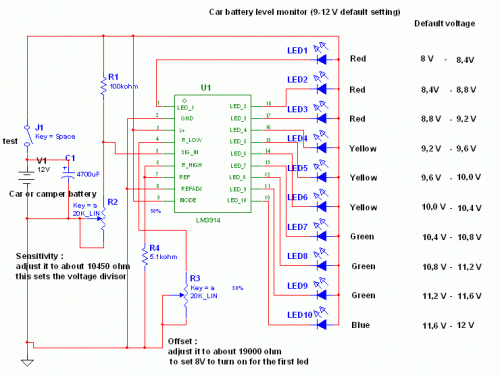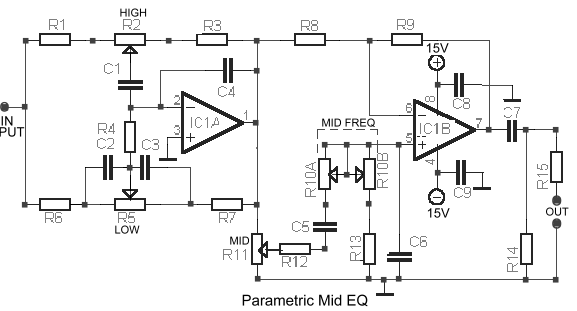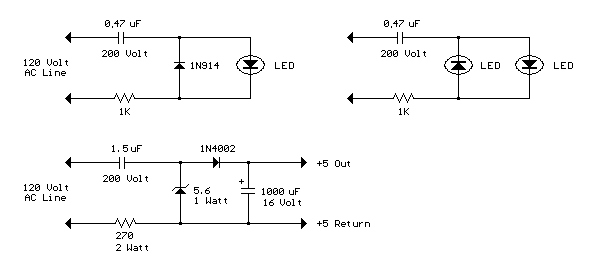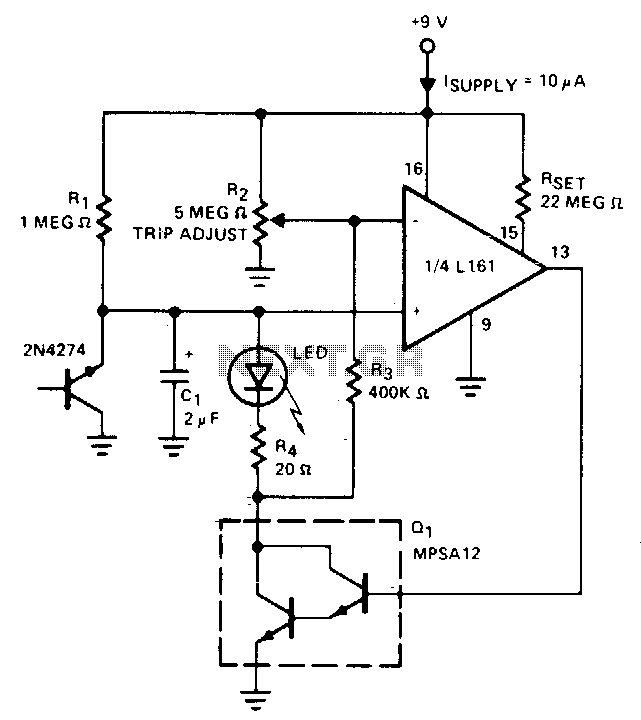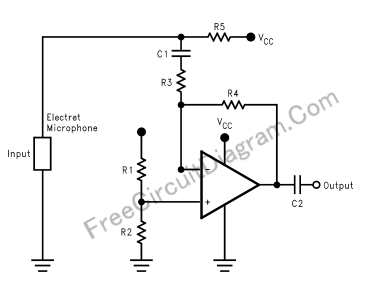
6088 Based Battery Powered Full Feature Preamp Part 3
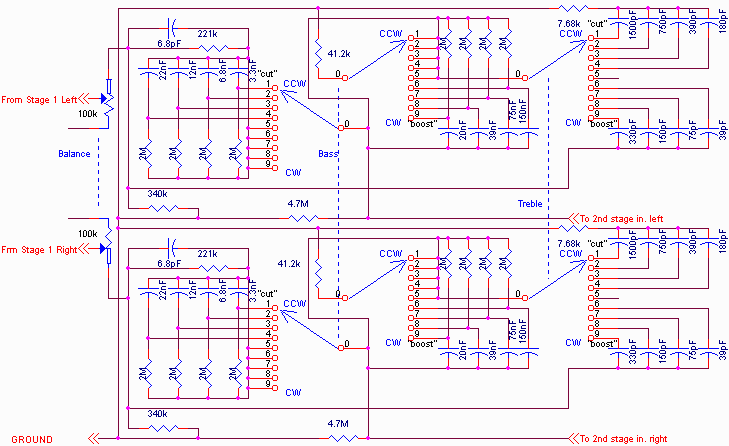
The primary amplifying stages consist of triode-connected 6088 tubes. As previously mentioned, there are two amplifying stages, which provide a non-inverted input to output connection and sufficient gain to include tone control. The tone controls are switch-selected, allowing a "flat" setting that bypasses all reactive elements for a truly flat response. The overall circuit topology is shown for completeness: the first stage is slightly starved, yielding a gain of approximately 9. This stage drives the tone control and balance circuits, introducing a loss of about 7. The second stage operates at a slightly higher current and has a lower plate resistor, resulting in a preamp output impedance of less than 10k. With a gain of about 8, the overall line stage achieves a gain of about 10 (20dB), producing approximately 10 VRMS with minimal distortion. The amplifier section is mounted on a separate board housing all six line-side amplifying tubes. To ensure consistency for any future modifications, a DC ground path is provided, isolating all inputs and outputs. This includes additional resistors and capacitors on the input and output sides of the amplifiers. While not always necessary, this approach guarantees a DC return regardless of the connected devices, with the exception of the input to the tape monitor, as the rest of the circuit maintains the idling potential at this point. The tape monitor output is isolated and utilizes a 6418, a smaller device, as a unity gain inverting buffer with low output impedance due to localized feedback in that stage. Notably, comparing the sound of the phono run directly from the direct phono output to the phono output from the tape monitor provides insight into the sound quality alterations introduced by that stage. Personal preferences vary regarding sound quality. A unique balance control, already available, is 100k with a center detent, and its control action operates over alternating physical halves of the control, resulting in an unusual representation in the schematic. A 6.8pF "gimmick" capacitor compensates for wiring capacitance and the input capacitance of the final stage, extending the overall frequency response to about 100kHz. The tone controls operate subtly; as the reactance (capacitor) is switched, the corner frequency changes with the control movement, offering a more favorable sound control than fixed capacitors and variable resistances, which tend to shift the maximum available boost/cut and corner frequency. This design also minimizes midrange interaction between bass and treble controls. High-value resistors in the bass cut section regulate the maximum cut, providing a shelf rather than continuous roll-off and reducing popping during switch changes. Similarly, resistors in the bass boost section also minimize popping, and while this could be applied to treble controls, smaller capacitor values in the treble section typically exhibit a more benign pop. Overall, the sound quality of this preamp is satisfactory. However, the selected batch of 6088 tubes displays high-frequency microphonics in both the line stage and phono section. During auditions with audiophiles, the issue was noticeable when the preamp was struck but was not apparent during regular listening. The inductor used in the loudness control may introduce some hum if the preamp is positioned near transformers or AC sources, suggesting that a shielded inductor would yield better performance, which was not utilized in this instance. Battery life aligns with prior calculations, indicating reasonable longevity, and the presence of two LED monitors makes it easy to determine when battery replacement is necessary.
The circuit employs a dual-stage architecture utilizing triode-connected 6088 tubes, which are known for their favorable linearity and low distortion characteristics. The first stage's slightly starved configuration not only provides the necessary gain but also ensures that the signal remains clean and well-defined before it is processed by the tone control circuits. The tone control section is designed for flexibility, allowing the user to engage a flat response that bypasses reactive components, thus maintaining signal integrity for critical listening applications.
The coupling between the first and second stages is crucial; the gain structure is carefully balanced to achieve an overall gain of approximately 20dB. The output impedance is maintained below 10kΩ, which is advantageous for driving downstream components without significant loading effects. The separate board for the amplifier section facilitates thermal management and reduces noise coupling between stages.
The design incorporates a DC ground path for enhanced stability and reliability, particularly important in audio applications where signal integrity is paramount. The inclusion of additional resistors and capacitors at the input and output stages serves to filter out unwanted noise and ensures a stable DC return, which is especially beneficial when interfacing with various audio sources.
The use of a 6418 as a unity gain buffer in the tape monitor output highlights the design's attention to detail, ensuring that signal integrity is preserved even when the output is routed through additional processing. The unique balance control design, while unconventional, allows for fine-tuning of the audio output, enhancing user experience.
The 6.8pF capacitor plays a critical role in maintaining frequency response, effectively compensating for the inherent capacitance in the circuit. The tone control mechanism, based on variable reactance, offers a sophisticated approach to sound shaping, minimizing unwanted interactions between frequency bands and providing a more musical response.
Overall, this preamp design exemplifies a thoughtful integration of components and circuit topology aimed at achieving high fidelity audio performance while maintaining user-friendly operation and adaptability for various listening preferences.The main amplifying stages are triode connected 6088 stages. As indicated from the previous part, there are two amplifying stages. This provides a non-inverted input to output connection, as well as sufficient gain to incorporate tone control. The tone controls are switch selected so that "flat" bypasses all reactive elements; truely flat response
. The overall circuit topology is again shown here for completeness: Notice that the first stage is slightly starved. This provides a gain of about 9. This drives the tone control and balance circuits that introduce a loss of about 7. 2. The second stage is operated at slightly higher current, and has a lower plate resistor, so that the preamp "output" impedance is less than 10k.
The second stage has a gain of about 8, so the overall "line" stage has a gain of about 10 (20dB). It will produce about 10VRMS without much distortion. The amplifier section is mounted on a separate board containing all 6 "line" side amplifying tubes. For consistency in any projected modifications to the circuit, I provided a DC ground path and isolated all inputs and outputs. That`s the extra r`s and c`s on the input and output sides of the amplifiers. You don`t always NEED to do this, but it does provide a guaranteed DC return no matter what you connect to it.
(The exception is the input to the tape monitor, since the rest of the circuit guarantees the idling potential at this point. ) The "tape monitor" output is isolated. The uses a 6418 (an even smaller device) as a unity gain inverting buffer which has a low output impedance by virtue of the "feedback" localized to that stage.
Interestingly, by comparing the sound of the phono run directly from the direct phono output to the phono output run from the tape monitor, you can get a good idea of what that stage does to the sound quality. (Some like it, some don`t). I happened to have "funny" balance control already at hand. The control is 100k, but there is a center detent, and the control action is over alternate physical "halves" of the control.
That`s why is shows oddly in the above schematic. The 6. 8pF "gimmick" capacitor compensates for the capacitance of the wiring and input capacitance of the final stage. This allows the overall frequency response to extend to about 100kHz. The tone controls are subtle in their action. Since the reactance (capacitor) is switched, the "corner" frequency changes as the control is moved. This provides a better sounding control (in my opinion) than fixed capacitor and variable resistance, which tends to shift the maximum available boost/cut as well as the corner frequency.
Also tends to minimize midrange interaction of the bass and treble controls as well. The high value resistors in the bass cut section control the maximum "cut" providing a shelf rather than continuing rolloff and also minimize "popping" as the switch is changed. The resistors in the bass boost section also minimize popping. In principle, this could be done for the treble controls as well. Usually, the smaller capacitor values associated with the treble section have a more benign "pop" anyway.
The sound of this preamp is not too bad overall. The batch of 6088s I used seem plagued by a high frequency microphonic noticeable in the line stage as well as the phono section. When I auditioned this preamp to a number of audiophiles, you could hear it if you "banged" on the preamp, but was not apparent in normal listening.
The inductor used in the "loudness" control introduces a little hum if the preamp is nearby any transformers or AC sources. For best results, this should be a "shielded" inductor. (which is NOT what I happened to use). Battery life appears to be consistent with the calculations I previously made. Reasonable lifetime can be expected. Since there are two LED monitors, it is easy to tell when the batteries need changed. 🔗 External reference
The circuit employs a dual-stage architecture utilizing triode-connected 6088 tubes, which are known for their favorable linearity and low distortion characteristics. The first stage's slightly starved configuration not only provides the necessary gain but also ensures that the signal remains clean and well-defined before it is processed by the tone control circuits. The tone control section is designed for flexibility, allowing the user to engage a flat response that bypasses reactive components, thus maintaining signal integrity for critical listening applications.
The coupling between the first and second stages is crucial; the gain structure is carefully balanced to achieve an overall gain of approximately 20dB. The output impedance is maintained below 10kΩ, which is advantageous for driving downstream components without significant loading effects. The separate board for the amplifier section facilitates thermal management and reduces noise coupling between stages.
The design incorporates a DC ground path for enhanced stability and reliability, particularly important in audio applications where signal integrity is paramount. The inclusion of additional resistors and capacitors at the input and output stages serves to filter out unwanted noise and ensures a stable DC return, which is especially beneficial when interfacing with various audio sources.
The use of a 6418 as a unity gain buffer in the tape monitor output highlights the design's attention to detail, ensuring that signal integrity is preserved even when the output is routed through additional processing. The unique balance control design, while unconventional, allows for fine-tuning of the audio output, enhancing user experience.
The 6.8pF capacitor plays a critical role in maintaining frequency response, effectively compensating for the inherent capacitance in the circuit. The tone control mechanism, based on variable reactance, offers a sophisticated approach to sound shaping, minimizing unwanted interactions between frequency bands and providing a more musical response.
Overall, this preamp design exemplifies a thoughtful integration of components and circuit topology aimed at achieving high fidelity audio performance while maintaining user-friendly operation and adaptability for various listening preferences.The main amplifying stages are triode connected 6088 stages. As indicated from the previous part, there are two amplifying stages. This provides a non-inverted input to output connection, as well as sufficient gain to incorporate tone control. The tone controls are switch selected so that "flat" bypasses all reactive elements; truely flat response
. The overall circuit topology is again shown here for completeness: Notice that the first stage is slightly starved. This provides a gain of about 9. This drives the tone control and balance circuits that introduce a loss of about 7. 2. The second stage is operated at slightly higher current, and has a lower plate resistor, so that the preamp "output" impedance is less than 10k.
The second stage has a gain of about 8, so the overall "line" stage has a gain of about 10 (20dB). It will produce about 10VRMS without much distortion. The amplifier section is mounted on a separate board containing all 6 "line" side amplifying tubes. For consistency in any projected modifications to the circuit, I provided a DC ground path and isolated all inputs and outputs. That`s the extra r`s and c`s on the input and output sides of the amplifiers. You don`t always NEED to do this, but it does provide a guaranteed DC return no matter what you connect to it.
(The exception is the input to the tape monitor, since the rest of the circuit guarantees the idling potential at this point. ) The "tape monitor" output is isolated. The uses a 6418 (an even smaller device) as a unity gain inverting buffer which has a low output impedance by virtue of the "feedback" localized to that stage.
Interestingly, by comparing the sound of the phono run directly from the direct phono output to the phono output run from the tape monitor, you can get a good idea of what that stage does to the sound quality. (Some like it, some don`t). I happened to have "funny" balance control already at hand. The control is 100k, but there is a center detent, and the control action is over alternate physical "halves" of the control.
That`s why is shows oddly in the above schematic. The 6. 8pF "gimmick" capacitor compensates for the capacitance of the wiring and input capacitance of the final stage. This allows the overall frequency response to extend to about 100kHz. The tone controls are subtle in their action. Since the reactance (capacitor) is switched, the "corner" frequency changes as the control is moved. This provides a better sounding control (in my opinion) than fixed capacitor and variable resistance, which tends to shift the maximum available boost/cut as well as the corner frequency.
Also tends to minimize midrange interaction of the bass and treble controls as well. The high value resistors in the bass cut section control the maximum "cut" providing a shelf rather than continuing rolloff and also minimize "popping" as the switch is changed. The resistors in the bass boost section also minimize popping. In principle, this could be done for the treble controls as well. Usually, the smaller capacitor values associated with the treble section have a more benign "pop" anyway.
The sound of this preamp is not too bad overall. The batch of 6088s I used seem plagued by a high frequency microphonic noticeable in the line stage as well as the phono section. When I auditioned this preamp to a number of audiophiles, you could hear it if you "banged" on the preamp, but was not apparent in normal listening.
The inductor used in the "loudness" control introduces a little hum if the preamp is nearby any transformers or AC sources. For best results, this should be a "shielded" inductor. (which is NOT what I happened to use). Battery life appears to be consistent with the calculations I previously made. Reasonable lifetime can be expected. Since there are two LED monitors, it is easy to tell when the batteries need changed. 🔗 External reference

